Introduction
Looking for your perfect running companion? The wrist-based tech race is hotter than ever in 2025, with everything from budget-friendly options to premium powerhouses vying for a spot on your arm. We've logged countless miles testing the latest GPS watches to bring you this comprehensive guide—breaking down the best options for every type of runner and running scenario.
Whether you're pounding city pavements, tackling gnarly trails, or training for your first 5K, we've got you covered. Let's dive into the watches that will take your running game to the next level this year!
Top 10 GPS Running Watches of 2025
We've evaluated these watches based on GPS accuracy, heart-rate monitoring reliability, battery performance, smart features, durability, and overall value. Plus, we've incorporated feedback from both elite athletes and everyday runners to ensure our rankings reflect real-world performance.
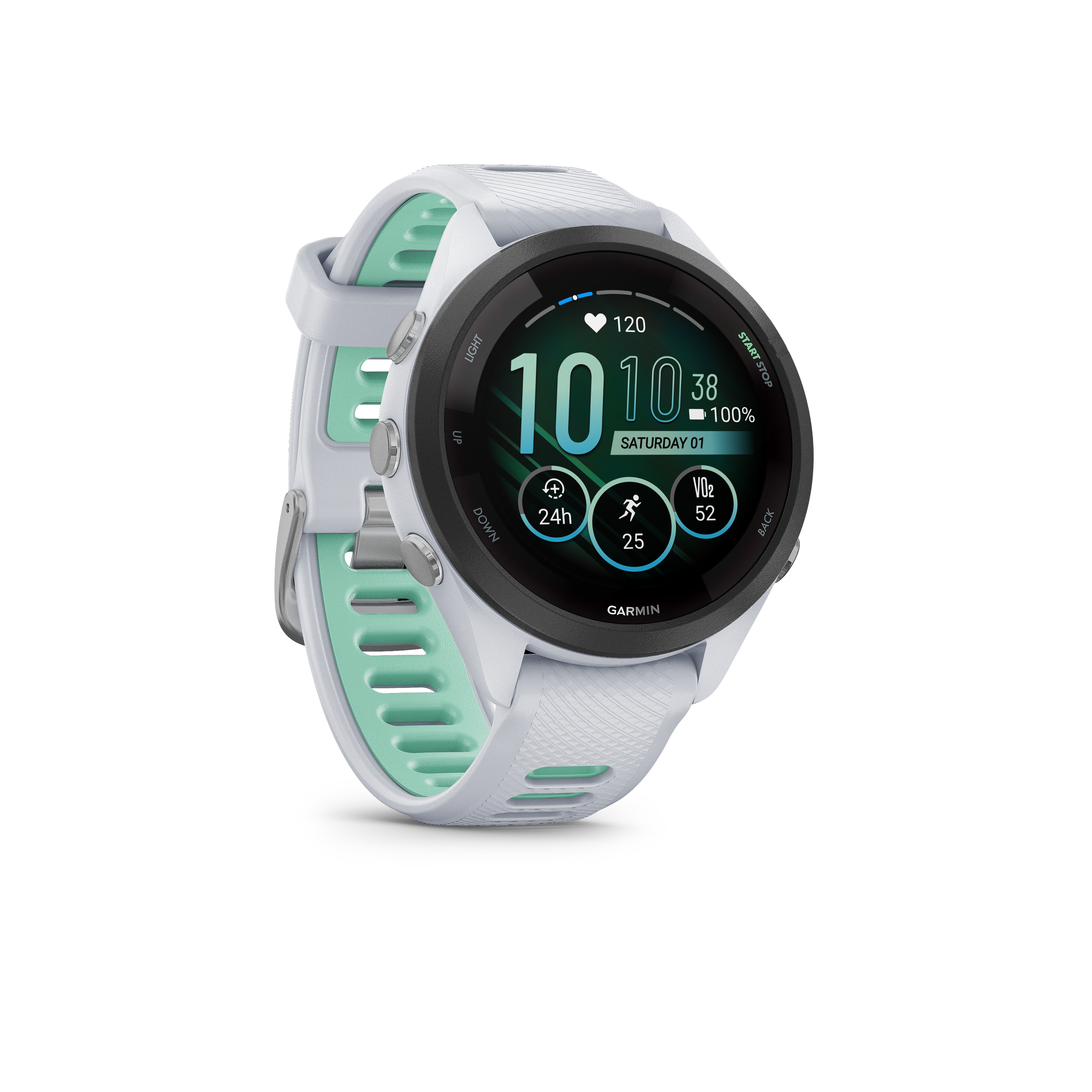
1. Garmin Forerunner 265 – Best All-Around Mid-Range
The Forerunner 265 is the Goldilocks of GPS watches—it's just right. Hitting that sweet spot between features and price, it delivers premium functionality without the premium price tag.
The vivid 1.3-inch AMOLED touchscreen (a first for the 200-series) is a game-changer, offering incredible visibility even under harsh sunlight. Don't worry about accidental swipes during those sweaty intervals, though—Garmin kept the trusty physical buttons for when you need reliable control.
What really impressed us was how many high-end features have trickled down from Garmin's flagship models. Multi-band GPS tracking means scary-accurate route tracking (it can tell which side of the street you're on!), and the on-wrist running power metrics were once reserved for watches costing hundreds more. They've even thrown in a triathlon mode, making this a versatile pick if you're thinking about branching out beyond running.
Battery life is robust—about 25 hours in GPS mode and up to two weeks as a regular smartwatch. At around $450, you're getting flagship-level accuracy and training insights in a lightweight (47g) package that won't weigh you down on race day.
The bottom line: If you want advanced metrics and reliable performance without spending ultra-premium money, the Forerunner 265 delivers in spades.
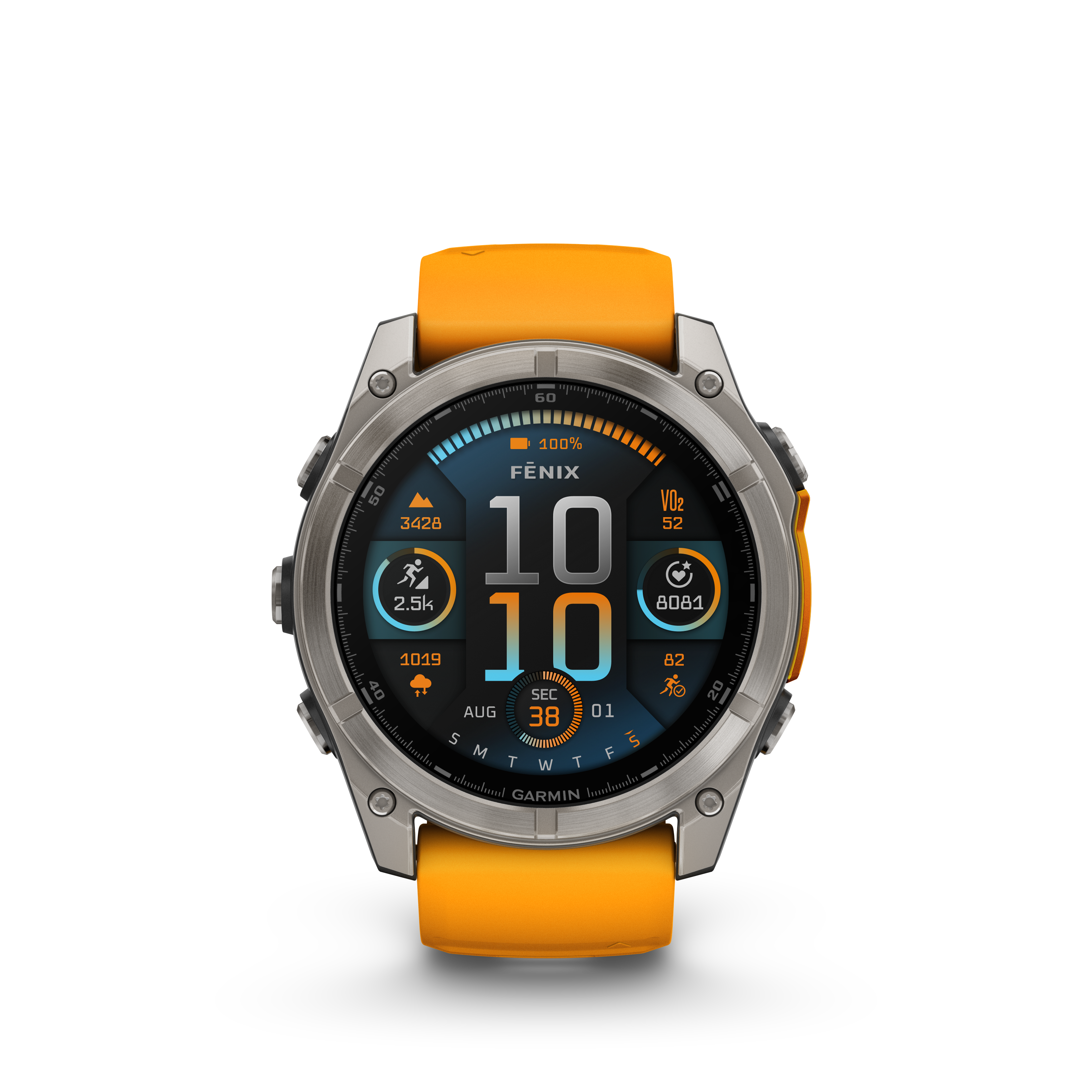
2. Garmin Fēnix 7X / Fenix 8 – Premium Multi-Sport Powerhouse
When it comes to the ultimate "do everything" outdoor watch, Garmin's Fenix series continues to reign supreme. The Fēnix 7X Sapphire Solar (and the anticipated Fenix 8 update) is basically the Swiss Army knife of GPS watches—if that knife also happened to be nearly indestructible.
This beast packs a 1.4-inch always-on display that's incredibly easy to read in bright sunlight, wrapped in either steel or titanium with a scratch-resistant sapphire crystal face. It's built like a tank but loaded with the brains of a sports scientist.
The feature list is almost overwhelming: wrist-based running power, mountain bike dynamics, real-time stamina tracking that tells you exactly how much gas you have left in the tank, plus full-color topographic maps that make getting lost nearly impossible. Multi-band GPS delivers pinpoint accuracy even in challenging environments like dense forests or urban canyons.
The battery life is frankly ridiculous—up to 89 hours in full GPS mode or more than 20 days as a regular watch. With solar charging, you can extend this even further if you're regularly running in sunny conditions.
Yes, at $900-$1000, it's an investment. And at 51mm and 96g, it's not exactly dainty. But for serious outdoor enthusiasts who demand every bell and whistle in a package that can survive apocalyptic conditions, nothing else comes close.

3. Apple Watch Ultra 2 – Best Smartwatch for Runners
The Apple Watch Ultra 2 answers the question: "What if Apple made a watch specifically for endurance athletes?" The result is impressive—a titanium-encased, sapphire-protected smartwatch that can finally compete with dedicated running watches in terms of durability and accuracy.
Despite being marketed primarily as a productivity tool, the Ultra 2 delivers surprisingly excellent running metrics. Its dual-frequency GPS tracking rivals specialized running watches, and the bright 3000-nit OLED display is crisp and clear in any lighting condition. The customizable Action Button is a thoughtful addition—program it to instantly launch your running workout and you're off with a single press.
Where the Ultra 2 really shines is in its connectivity. The seamless iPhone integration means you can call, text, stream music, use Apple Pay, and access countless apps right from your wrist. For urban runners or those who balance running with a busy lifestyle, this level of connectivity is a genuine game-changer.
Battery life, while vastly improved over standard Apple Watches, remains the main compromise compared to dedicated running watches—expect about 12-17 hours of continuous GPS tracking. That's enough for all but the longest ultras, and up to 36 hours with optimizations.
The caveat? You'll need an iPhone—there's no Android compatibility. But if you're in the Apple ecosystem and want one watch that excels both during runs and everyday life, the Ultra 2 has finally bridged the gap between smartwatch convenience and serious athletic functionality.
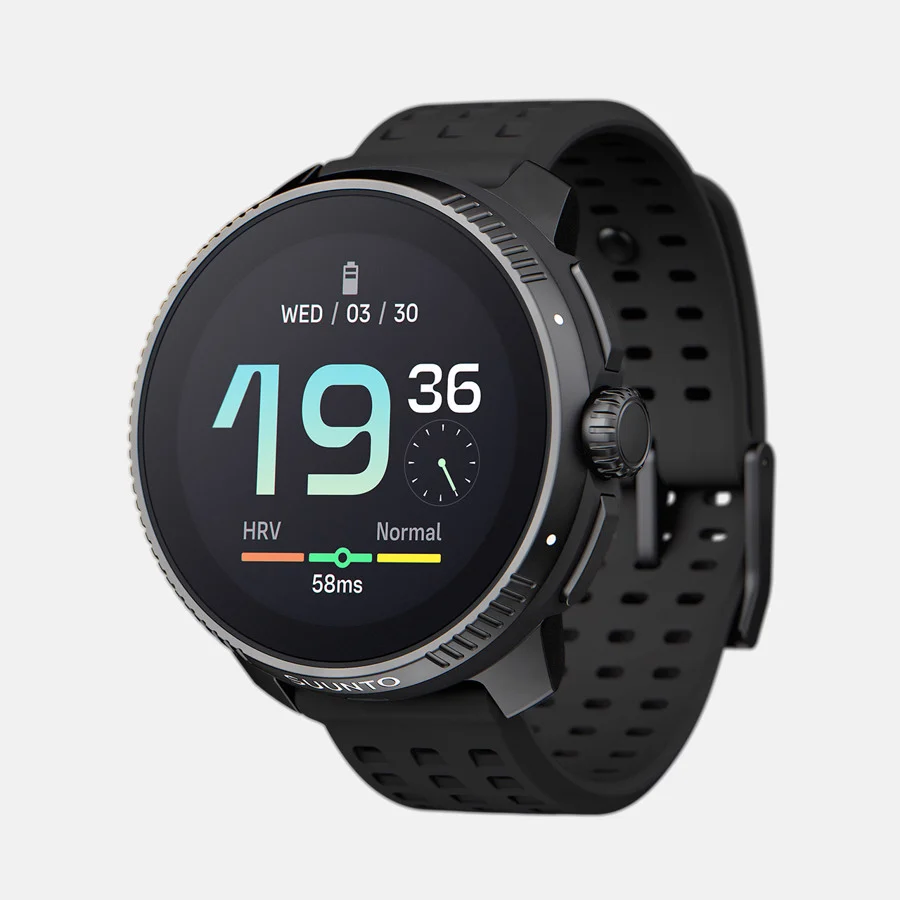
4. Suunto Race – Feature-Packed Challenger with Value
Suunto made quite the comeback with their Race model, offering premium features at a mid-range price point ($450). The sleek design houses a bright 1.4-inch display and dual-frequency GPS that rivals much pricier competitors in accuracy.
Battery life is a strong point—40 hours in GPS mode is enough for most ultras, and the ability to fast-charge from empty to full in under an hour is a genuine convenience that runners will appreciate.
The Suunto Race nails all the essentials: turn-by-turn directions, Strava Live Segments, structured workouts, and native running power support. It even includes thoughtful touches like a built-in flashlight mode (the screen fully illuminates) for those pre-dawn or late evening runs.
While it lacks some of the extras found in top-tier Garmins (the mapping is more basic, and there's no offline music), the Suunto Race delivers the fundamentals in a stylish package that transitions well from trail to office. The high-contrast display earns particularly high marks, though some users noted occasional menu lag from a slightly slower processor.
For runners seeking high-end capabilities without the high-end price tag, the Suunto Race offers a compelling balance of performance, style, and value.
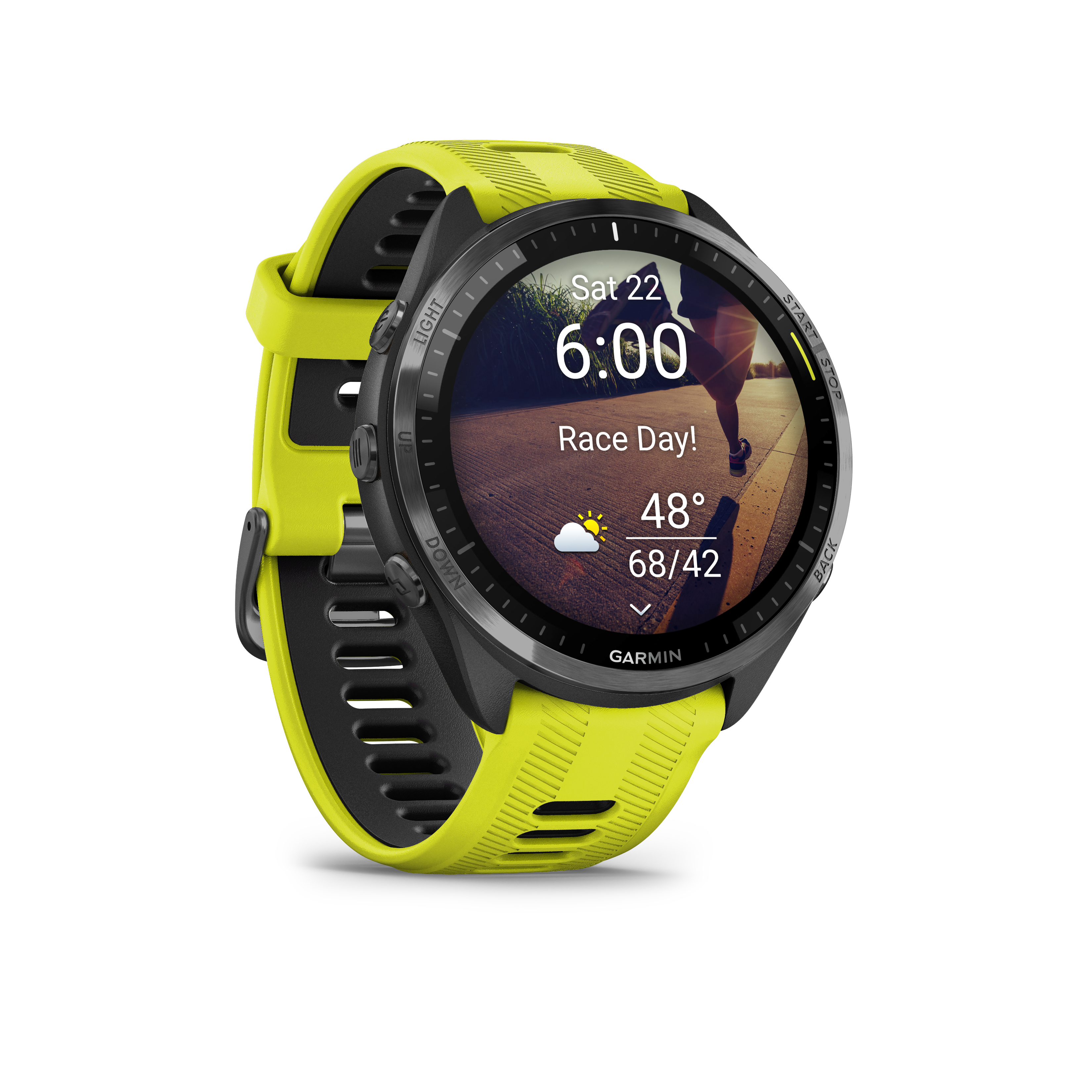
5. Garmin Forerunner 965 – Flagship Running/Tri Watch
If you're serious about your running data but want something lighter than the tank-like Fenix, the Forerunner 965 is your perfect match. This lightweight flagship (53g) packs premium materials (titanium bezel) and a gorgeous AMOLED touchscreen into a slim 47mm case.
The FR965 delivers everything a data-hungry runner could want: pinpoint-accurate multi-band GPS, full-color maps, wrist-based running dynamics, and Garmin's complete suite of training analytics (including the helpful Morning Readiness Report that tells you whether to push hard or take it easy).
In our testing, its dual-frequency GPS and optical heart-rate accuracy were exceptional, nearly matching chest straps even during high-intensity intervals. Despite the beautiful high-res screen, it still manages about 30 hours of GPS runtime—plenty for marathons and even 100K ultras.
At $600, it's definitely an investment, but you're getting the full Garmin ecosystem—comprehensive health metrics, smartphone notifications, Garmin Pay, and extensive app integrations—in a package that's comfortable enough for 24/7 wear.
The FR965 earned an Editor's Choice award in our testing for good reason—it strikes an ideal balance of performance, reliability, and cutting-edge tech that will satisfy everyone from track athletes to Ironman triathletes.
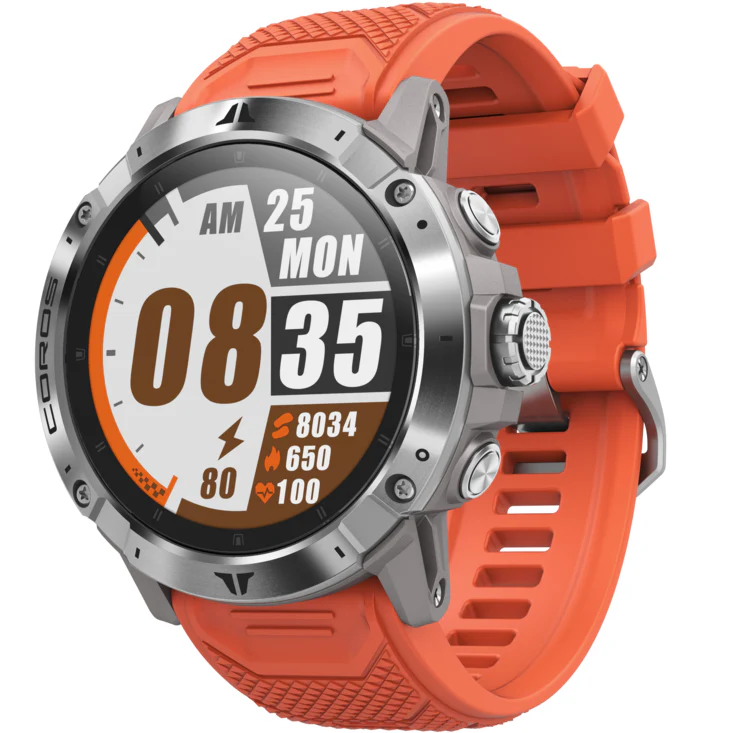
6. Coros Vertix 2 (Vertix 2S) – Ultra-Endurance Adventure Watch
When battery life is your top priority, the Coros Vertix 2 is simply untouchable. This expedition-grade GPS watch is the ultimate companion for ultramarathoners and adventure racers who measure their activities in days rather than hours.
The battery stats are mind-boggling: up to 140 hours in standard GPS mode (60 hours in the highest accuracy dual-frequency mode), or an astounding 50 days of regular use. In our real-world testing, the newer Vertix 2S variant logged about 118 hours of GPS tracking on a single charge—the longest of any watch in this guide by a considerable margin.
This endurance monster is built to match its battery: titanium alloy bezel, scratch-resistant sapphire glass, and 10 ATM water resistance (suitable for diving). The 1.4" display uses power-efficient memory-LCD technology, and the watch leverages all five major satellite systems simultaneously with dual-frequency GNSS for rock-solid tracking even in the most challenging conditions.
The tradeoff is its bulk—at 89g, the Vertix 2 is substantial on the wrist, and some users find it too large for everyday wear. It also lacks some of the lifestyle features found in competitors (its smartwatch functions are more limited than Garmin's).
Priced around $700, it's competing with flagship models from the major brands, but for endurance specialists who routinely push beyond 24 hours, the Vertix 2's unmatched battery endurance and reliability make it worth every penny.

7. Polar Vantage V3 – High-Tech Training and Recovery Tool
Polar's Vantage V3 represents the brand's triumphant return to the premium GPS watch conversation. Launched in late 2023 at $599, it finally modernized Polar's hardware with features competitors had for years: offline mapping, a brilliant 1.39" AMOLED display, and dual-frequency GPS.
But where Polar has always excelled—physiological tracking and training analysis—the V3 continues to lead the pack. The heart rate monitoring accuracy and training load analysis remain best-in-class, presenting a wealth of metrics in formats that athletes find genuinely useful rather than overwhelming.
New hardware additions like ECG and SpO₂ sensors, plus Polar's "Elixir™" algorithm fusion for enhanced sleep and recovery tracking, demonstrate the brand's continued focus on holistic athlete development.
Battery performance is solid: up to 61 hours of GPS training on paper (our testing found closer to 35-40 hours in full-resolution mode) or about 12 days as a daily watch. At 57g with a 47mm case, it's comfortable even for smaller wrists.
What you won't find are onboard music storage or an extensive app ecosystem like Garmin's. But for data-driven runners who prioritize training load management, recovery optimization, and physiological insights, the Vantage V3 delivers in spades, finally backed by hardware that matches its analytical prowess.
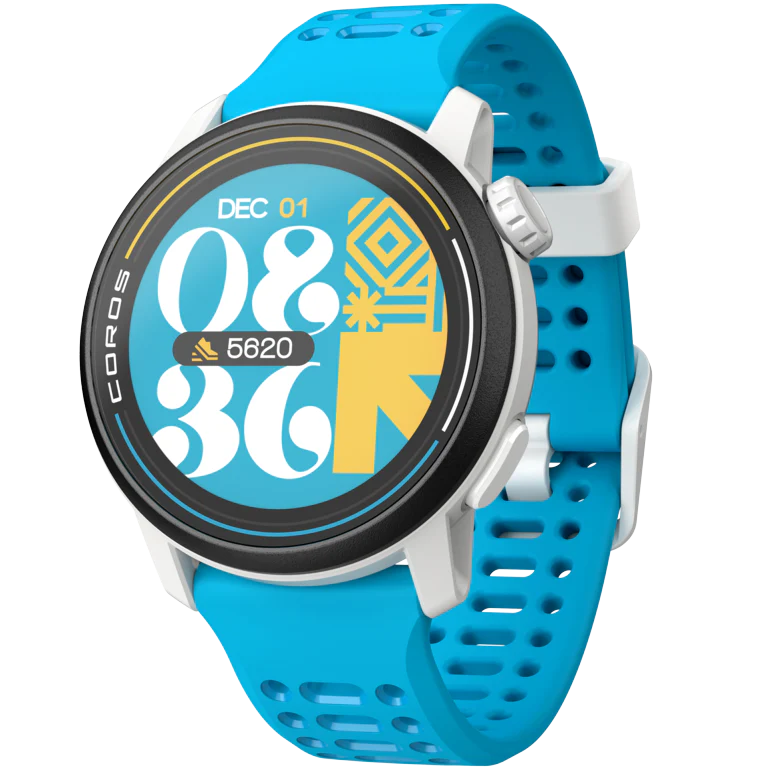
8. COROS Pace 3 – Best Budget GPS Watch
If we were giving out awards for "most impressive value in running tech," the COROS Pace 3 would win in a landslide. At just $229, this watch delivers features and performance that compete with models costing two to three times more.
The Pace 3 significantly upgraded from its predecessor with dual-frequency GNSS (using GPS, GLONASS, Galileo, BeiDou, and QZSS) for exceptional accuracy even in challenging environments. Our urban testing found GPS tracks stayed clean in areas where previous watches would lose signal between buildings.
The optical heart rate sensor also got a serious boost, now featuring a 5-LED/4-photodiode array similar to higher-end COROS models for better heart-rate accuracy during variable intensity workouts.
Battery life is outstanding for the price range: 38 hours in GPS mode or up to 20 days for regular use—far outlasting similarly priced competitors.
What's truly impressive is that COROS doesn't skimp on training analytics—you get detailed metrics like running power, ground contact time, left/right balance, and VO2 max estimations that are typically reserved for watches costing $400+. It even supports track run mode with lane calibration and basic navigation features.
All this comes in an ultra-lightweight build (just 30g with the nylon band) that you'll barely notice during workouts. The simple memory LCD isn't as flashy as AMOLED screens, and some users found the button-plus-scroll-wheel interface less intuitive than touchscreens, but these are minor compromises given the value proposition.
For beginners or budget-conscious runners, the Pace 3 delivers professional-grade accuracy and training depth at an entry-level price—making it our top value pick of 2025.
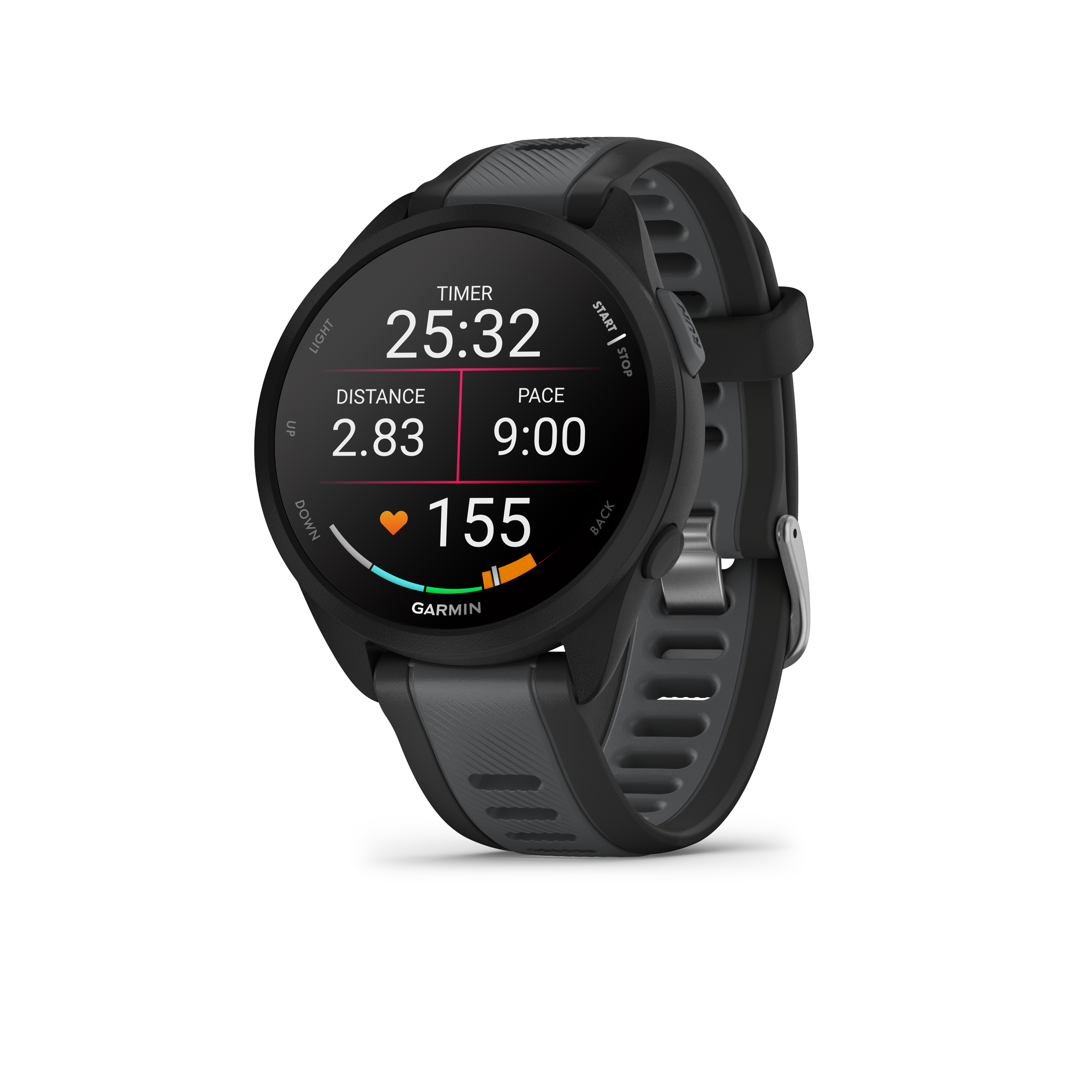
9. Garmin Forerunner 165 Music – Beginner-Friendly with Music Storage
The newest addition to Garmin's lineup targets runners seeking simplicity without sacrificing essential functionality. At around $300, the Forerunner 165 Music delivers an impressive feature set that covers what most runners actually need.
Despite being positioned as an entry-level watch, the FR165 includes accurate optical heart rate, reliable GPS tracking, and even training plan guidance. The standout feature at this price point is onboard music storage (up to 500 songs)—a rarity in sub-$300 watches that lets you leave your phone at home and still enjoy your favorite playlists via Bluetooth headphones.
The 1.2" color display is clear and readable, and while it lacks the multi-band GPS of pricier models, we found its tracking accuracy more than sufficient for reliable pace and distance data. Battery life is solid for an entry-level unit: about 19-20 hours in GPS mode (enough for a full-day ultramarathon) and up to 7-10 days in watch mode.
Garmin has equipped it with their latest software features like morning reports and Connect IQ app support, so it doesn't feel like you're getting last year's technology. The watch is lightweight (42g) and one of the simplest to use—perfect for beginners or those who prefer straightforward operation without complex menus.
It does lack some advanced metrics (no Training Load or Recovery Time estimates) and doesn't have a barometric altimeter or triathlon mode, but these omissions align with its focus on essential running and fitness tracking.
For new runners, casual runners, or anyone wanting Garmin quality without breaking the bank, the Forerunner 165 Music offers tremendous value in a user-friendly package.

10. Suunto 9 Peak Pro Titanium – Sleek Design and Durability
The Suunto 9 Peak Pro earns its spot in our top 10 by combining premium build quality with solid performance in a refreshingly slim form factor. For those who find most GPS watches too bulky, the 9 Peak Pro's 43mm case is a welcome alternative that doesn't compromise too much on features.
The titanium version is frequently described as the most aesthetically pleasing GPS watch on the market—extremely sleek with a sapphire crystal lens and grade 5 titanium bezel that balances elegance with ruggedness. At 55g, it's lighter and lower-profile than many competitors, making it comfortable for all-day wear and ideal for athletes with smaller wrists.
Despite its slimmer profile, battery performance is impressive: up to 40 hours in best GPS mode and several weeks in daily use. It offers all the core multisport tracking features—accurate GPS, wrist heart rate, barometer, compass, and support for swimming, cycling, running, and triathlon—plus Suunto's reliable route navigation with turn-by-turn alerts.
The interface is simple and button-driven (with basic touchscreen functionality for map panning), which many users appreciate for reliability in wet or cold conditions. Suunto significantly improved the processor over previous models, eliminating most of the lag that plagued earlier versions.
Quick charging is another highlight—the watch goes from empty to full in about an hour, perfect for a quick top-up before heading out the door.
The mapping capabilities are more basic than Garmin's (breadcrumb style rather than detailed topographic maps), and some users reported occasional software quirks requiring a reset. But for athletes who value form alongside function, or who found other flagship watches too chunky, the 9 Peak Pro offers an excellent combination of premium materials, toughness, and reliability in a more refined package.
Top 10 Specs Summary
| Watch Model | Category | Price (USD) | Battery Life (GPS) | Notable Features |
|---|---|---|---|---|
| Garmin Forerunner 265 | Mid-Range | ~$450 | 25 hours | AMOLED display, Multi-band GPS, Music, Tri-mode |
| Garmin Fēnix 7X Sapphire | High-End | ~$999 | 84 hours (Solar) | Sapphire Solar, Maps/Navigation, 10 ATM, All sensors |
| Apple Watch Ultra 2 | High-End | $799 | ~17 hours (GPS) | OLED 3000 nit, Dual-frequency GPS, Cellular, Apps |
| Suunto Race | Mid-Range | $450 | 40 hours | Dual-band GPS, Fast-charge, Flashlight, Training guides |
| Garmin Forerunner 965 | High-End | $599 | ~30 hours | AMOLED, Maps, Multi-band, Tri-mode, Lightweight |
| COROS Vertix 2 | High-End | $699 | 118 hours | Ultra battery, Dual-frequency GNSS, Offline maps, 10 ATM |
| Polar Vantage V3 | High-End | $599 | 61 hours (max) | AMOLED, Dual-frequency, ECG, Advanced recovery metrics |
| COROS Pace 3 | Budget | $229 | 38 hours | Dual-frequency GPS, Very light (30g), Running power |
| Garmin Forerunner 165 | Budget | $300 | 19 hours | Easy-to-use, Music (500 songs), Training plans, 5 ATM |
| Suunto 9 Peak Pro | High-End | $699 | 40 hours | Titanium/sapphire, Compact design, Fast-charge, 10 ATM |
Best Watches for Trail Runners
Trail runners need ruggedness, reliable navigation, and long battery life from their watches. Key features include excellent GPS accuracy in remote areas, barometric altimeters for elevation, breadcrumb/turn-by-turn navigation, and durability to handle mud, rocks, and falls. Here are our top picks for the trail:
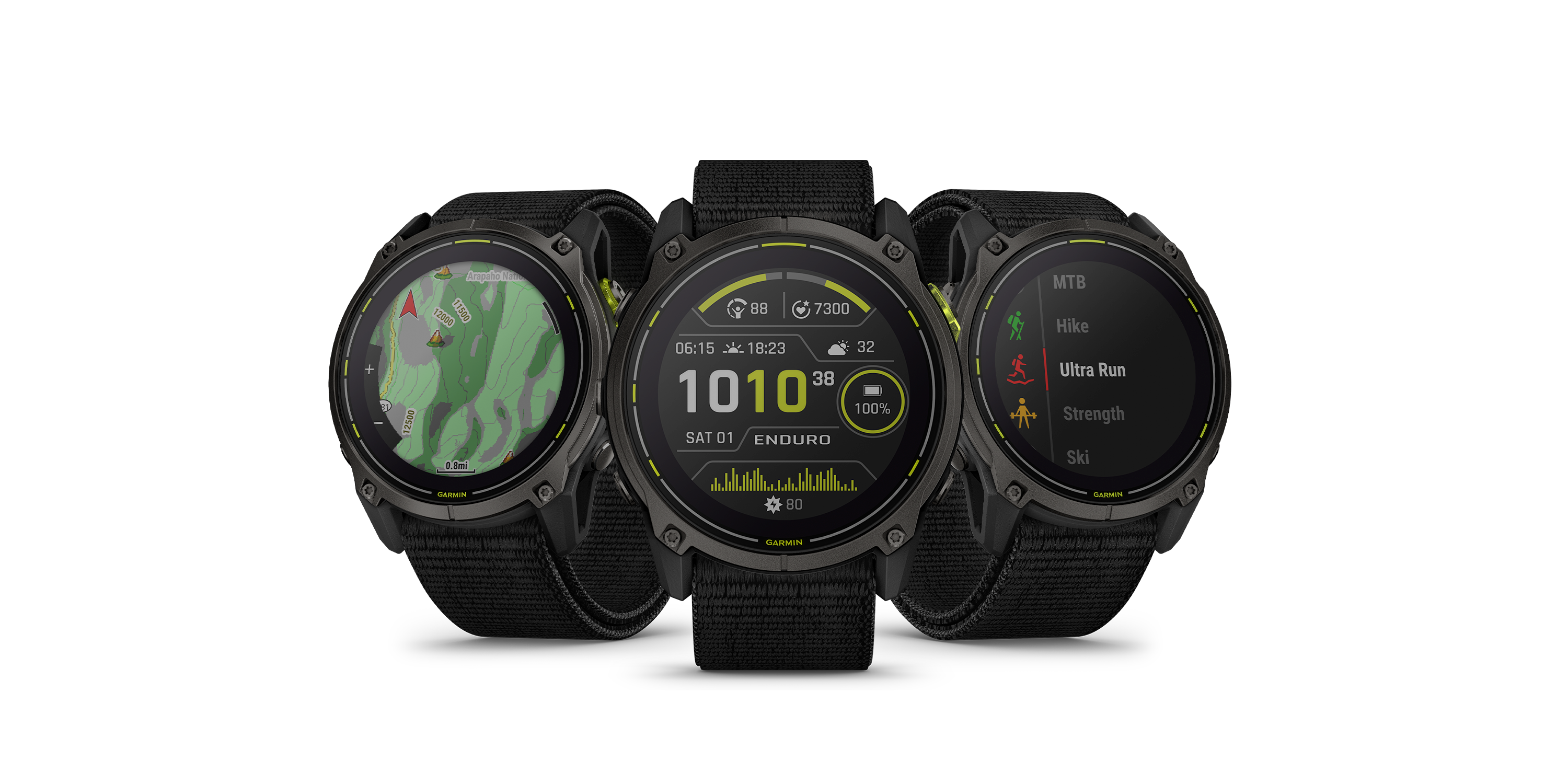
1. Garmin Fēnix 7X / Enduro 3
The Fenix 7X (and the battery-optimized Enduro series) is a trail runner's dream machine. It offers multi-band GPS with detailed topographic maps, a barometer/altimeter for accurate elevation tracking and weather change warnings, and a virtually indestructible metal body with sapphire lens that shrugs off scratches and impacts.
Battery life extends to 80+ hours (or an incredible 150 hours on the Enduro 3), easily covering even the most grueling 100-mile races. The built-in flashlight is surprisingly useful for pre-dawn starts or late finishes, and safety features like Incident Detection and SOS functionality provide peace of mind in remote areas.
The navigation capabilities are unmatched—back-to-start functionality, pre-loaded courses, and turn prompts keep you on track even in confusing terrain. Trail veterans consistently praise the Fenix for its reliability when deep in the backcountry.
The only downsides? Weight and cost. But when you're tackling serious trails far from civilization, the Fenix's bombproof reliability and comprehensive feature set are worth every gram and dollar.
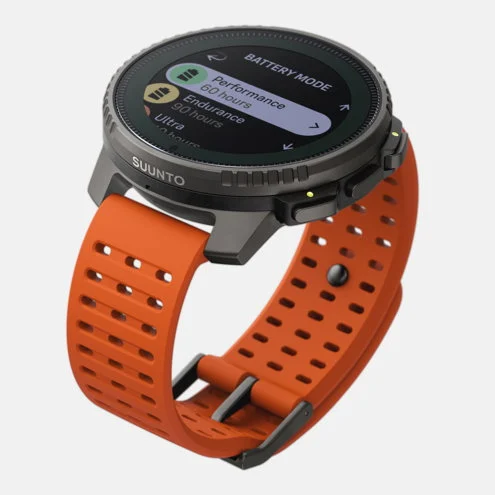
2. Suunto Vertical
Purpose-built for mountain adventures, the Suunto Vertical (especially the Titanium Solar version) offers perhaps the longest battery in the industry for a watch with maps—up to 85 hours in best GPS mode and a staggering 500 hours in expedition mode. This makes it ideal for multi-day trail ultramarathons or fastpacking adventures.
The large transflective display is easy to read in bright sunlight, and Suunto's renowned altitude and weather tracking features (including storm alarms) are particularly valuable in changing mountain conditions. The construction is bombproof—sapphire glass, titanium case, and 100m water resistance.
While it's a substantial presence on the wrist, many trail runners appreciate its battery endurance and straightforward, fail-safe interface that won't let you down when you're exhausted and need reliable information.

3. COROS Vertix 2
For ultra-distance trail runners, the Vertix 2 stands apart when it comes to battery endurance and toughness. With up to 5+ days of continuous GPS tracking, you can complete an entire mountain ultra or fastpack a multi-day route without even thinking about battery anxiety.
Its ability to lock onto all five major satellite systems simultaneously ensures robust coverage even in challenging terrain like slot canyons or dense forests. The built-in altimeter, compass, and downloadable landscape maps provide comprehensive navigation support.
The Vertix 2 is tested to extreme conditions (-4°F, high altitude)—it's literally built to survive environments that would challenge human endurance. It is heavier than some alternatives and lacks certain refinements (no music or contactless payments), but trail runners who've relied on the Vertix for 200-mile races consistently praise the peace of mind its massive battery and bulletproof durability provide.
Best Watches for Run Commuters
"Commuter" runners integrate running into their daily travel routine—whether running to work or squeezing in miles during lunch breaks. Their ideal watch combines running features with everyday conveniences. Key considerations include all-day comfort, strong smartwatch capabilities, and safety features for urban environments. Here are our top picks for run commuters:

1. Apple Watch Ultra 2
The Ultra 2 is perfect for run commuters in the Apple ecosystem. You can receive calls and texts, use Apple Pay for a post-run coffee, and stream music or podcasts directly from the watch—all without carrying your phone.
The bright screen is easy to read at a glance while running, and turn-by-turn directions via apps help navigate unfamiliar routes. Safety features like the loud siren and automatic fall detection provide extra security during solo runs in urban environments.
Battery life easily covers a full day that includes a commute run (typically 36 hours of mixed use), and while it's bulkier than a regular smartwatch, it's still sleek enough to wear in professional settings without looking out of place.
For commuters who value productivity and seamless integration with their digital life, the Ultra 2 offers an unbeatable combination of connectivity and capable run tracking—essentially giving you a phone on your wrist that's also a serious fitness device.

2. Garmin Forerunner 265
The FR265 shines for city commuters due to its slim, lightweight design that remains comfortable throughout the workday and fits easily under shirt cuffs. It offers a robust set of conveniences—smartphone notifications, Garmin Pay, and music storage—while delivering accurate tracking for your runs.
Its multi-band GPS performs exceptionally well in urban environments, maintaining accuracy even among tall buildings where single-band watches often struggle. Commuters will appreciate features like Morning Report (which helps gauge recovery before your morning run) and safety/live tracking to share your location with family or partners.
The impressive battery life (up to 13 days in smartwatch mode) means you can track your daily commute runs while wearing it 24/7 for nearly two weeks without charging—no need to carry a charger to the office.
The FR265 strikes an ideal balance between serious running features and daily wearability, making it a perfect companion for integrating running into your work routine.

3. Garmin Vivoactive 5 / Venu 3
These Garmin models are hybrid fitness smartwatches that excel for commuters who prioritize style alongside functionality. Both offer comprehensive smartwatch features (texts, calendar, payments, music) in designs that transition seamlessly from running gear to business attire.
While they have slightly fewer training metrics than dedicated running watches like the Forerunner series, they still provide everything casual to intermediate runners need—accurate GPS, heart rate monitoring, VO₂ max estimation, and guided workouts.
The Venu 3 adds a speaker and microphone, allowing Android users to take phone calls directly from the watch (a feature Apple users enjoy with Apple Watch). Battery life ranges from 4-6 days, easily covering a typical work week.
These watches also excel at stress tracking and all-day health monitoring, helping commuters manage work-life balance more effectively. If your runs are primarily moderate in intensity and you value a watch that looks as good in the office as it performs on the run, these hybrid options deserve serious consideration.
Best Watches for Track Athletes
Track athletes have unique needs: precise lap timing, comprehensive interval training features, lightweight design, and detailed metrics like splits, cadence, and running dynamics. The ideal track watch facilitates structured workouts without getting in the way of performance. Here are our top recommendations:

1. COROS Pace 3
The Pace 3's featherweight build (30g with nylon strap) makes it a favorite among competitive runners, including track specialists. Its dedicated Track Run mode cleverly uses algorithms to snap GPS data to standard 400m track dimensions, delivering highly accurate lap distances and splits without needing additional footpods.
The watch provides comprehensive running dynamics data (cadence, stride length, ground contact time) that track runners and coaches can use to fine-tune form and efficiency. With dual-frequency GPS, it maintains exceptional accuracy for road sessions too, but on the track specifically, it excels—consistently delivering precise interval distances where older watches might cut corners or add extra meters.
Programming interval workouts is straightforward through the COROS app, and they sync seamlessly to the watch. Perhaps most importantly for track work, the Pace 3 is so light and comfortable that it practically disappears on your wrist during intense repeats.
The simple transflective display isn't as flashy as AMOLED screens, but it remains readable in bright outdoor conditions—perfect for track sessions under the sun. At its budget price point, it's also an excellent option for student athletes or those just getting serious about track work.

2. Garmin Forerunner 965
For track athletes who also compete in road racing or triathlon, the FR965 provides a premium experience that covers all bases. Like COROS, it offers a specialized track mode that adjusts GPS for standard track geometry, ensuring accurate splits during interval sessions.
The FR965 truly shines with its advanced interval training functionality—you can create complex workouts with varying intensities, distances, and rest periods, and the watch guides you through each segment with clear vibration and audio alerts. Post-workout, its detailed analysis of each interval's pace consistency and heart rate recovery provides valuable insights for training optimization.
At 53g, it's significantly lighter than watches like the Fenix, making it comfortable for fast track repeats. Track athletes also benefit from the FR965's sophisticated training load and recovery metrics, which help balance high-intensity track sessions with appropriate recovery to prevent overtraining.
The bright AMOLED screen offers excellent visibility for checking split times at a glance, even in variable lighting conditions. While some sprinters might prefer a simpler device for actual competition, for comprehensive training support, the FR965 gives track athletes everything they need to optimize performance.

3. Polar Vantage V3
Polar's watches have long been favored by track and field coaches for their heart-rate accuracy and training analysis capabilities. The Vantage V3 continues this tradition with exceptional HR tracking (particularly valuable for tempo runs and analyzing recovery between intervals) and Polar's unique testing features.
The V3 offers specialized assessments like the Running Performance Test and Orthostatic Test, which provide objective data on fitness improvements and recovery status—particularly valuable for middle-distance runners fine-tuning their training.
At 57g with a low-profile design, it won't interfere with arm swing during powerful track sessions. While Polar doesn't offer a specific "track mode" like Garmin and COROS, its dual-band GPS delivers reliable accuracy for most track workouts.
Where Polar excels for track athletes is in training analysis—automatically calculating how high-intensity interval sessions affect different physiological systems compared to endurance runs, helping middle and long-distance runners balance their training effectively. The FitSpark feature can even suggest appropriate follow-up workouts based on recovery status, which is invaluable after hard track sessions or meets.
Polar's wrist-based heart rate technology is particularly adept at handling the rapid heart rate changes that occur during interval training, and the clear presentation of this data in the Polar Flow app makes it a favorite among coaches monitoring their athletes' progress.
Best Watches for City Runners
Urban runners face unique challenges like GPS interference from tall buildings, and often prioritize safety and connectivity features. The ideal city running watch offers accurate tracking in challenging environments, plus conveniences that enhance the urban running experience. Here are our top picks:

1. Garmin Forerunner 265
The FR265's multi-band GPS technology significantly improves tracking accuracy in urban environments—maintaining clean routes even among skyscrapers and accurately capturing which side of the street you're running on. This reliability ensures you get accurate pace and distance data even in the most challenging city conditions.
Safety features like LiveTrack (which allows someone to follow your run in real-time) and Incident Detection (which can automatically alert emergency contacts if you fall) provide valuable peace of mind for solo city runs. The bright AMOLED screen is easily visible in both bright daylight and under street lighting at night.
The watch's music storage and Garmin Pay capabilities mean you can head out the door without carrying extras—perfect for spontaneous runs or when you want to travel light but might need to pick up water or hop on public transit mid-run.
With its modern design and manageable 46mm size, the FR265 looks appropriate in urban settings while delivering all the performance features serious city runners need. Its ability to seamlessly sync with popular platforms like Strava makes it easy to share your urban adventures and connect with local running communities.

2. Garmin Epix Pro (Gen 2)
For city runners who want premium features and detailed mapping, the Epix Pro is exceptional. Available in multiple sizes (42, 47, or 51mm), you can choose a version that fits your preference for screen size versus bulk.
Its combination of multi-band GPS and full-color maps makes exploring new urban routes a breeze—you can discover new neighborhoods with confidence, knowing you won't get lost. The vibrant AMOLED display makes these maps and your running data easily visible in any lighting conditions.
City-specific features include Garmin's Transit profiles (perfect for recording combined run-transit commutes) and points of interest on maps that help you locate the nearest parks, water fountains, or coffee shops. The built-in flashlight is surprisingly useful for navigating poorly lit areas or increasing visibility to traffic during early morning or evening runs.
With its sapphire glass and metal construction, the Epix Pro is both stylish enough for everyday urban wear and tough enough to survive city hazards. While it's one of the pricier options (~$900), it essentially provides the ultimate combination of smartwatch convenience and hardcore GPS functionality—ideal for dedicated city runners who view the urban landscape as their personal playground.
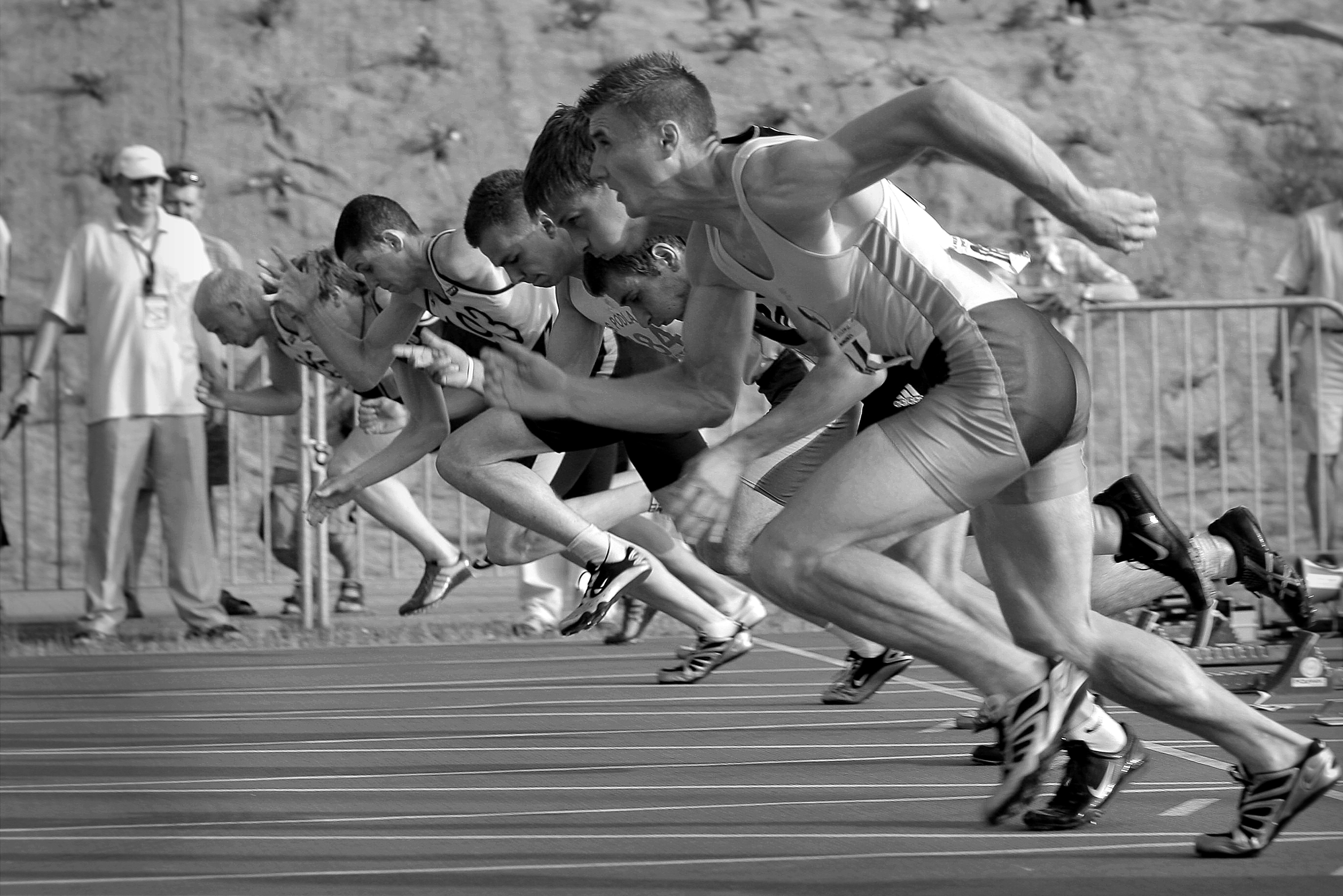
3. COROS Pace 3
The budget-friendly COROS Pace 3 proves that accurate city running doesn't require a premium price tag. Its dual-frequency GNSS technology handles urban environments remarkably well—maintaining clean tracking even in downtown areas with tall buildings where other watches in this price range typically struggle.
The lightweight, low-profile design makes it comfortable for all-day wear and unobtrusive during runs. While it lacks built-in music or contactless payments, it does provide smartphone notifications to keep you connected.
The exceptional battery life (38 hours GPS, up to 20 days regular use) means you could complete a week of city runs without charging—perfect for busy urban dwellers. Its improved heart rate sensor also performs well during the stop-and-start nature of city running, where traffic lights and crosswalks create variable pacing.
COROS also includes practical features like nutritional alerts that remind you to hydrate or fuel—particularly valuable during long urban runs in hot conditions. While it may not have all the bells and whistles of premium models, the Pace 3 delivers outstanding core performance at an accessible price point, making it our value pick for city runners.
Best Watches for Ultra-Marathoners
Ultra runners push equipment to extremes, demanding watches that can track continuously for 10, 30, or even 50+ hours while providing reliable navigation and data. Battery endurance, durability, and navigation capabilities become critical when events stretch beyond marathon distance. Here are the best options for ultra enthusiasts:
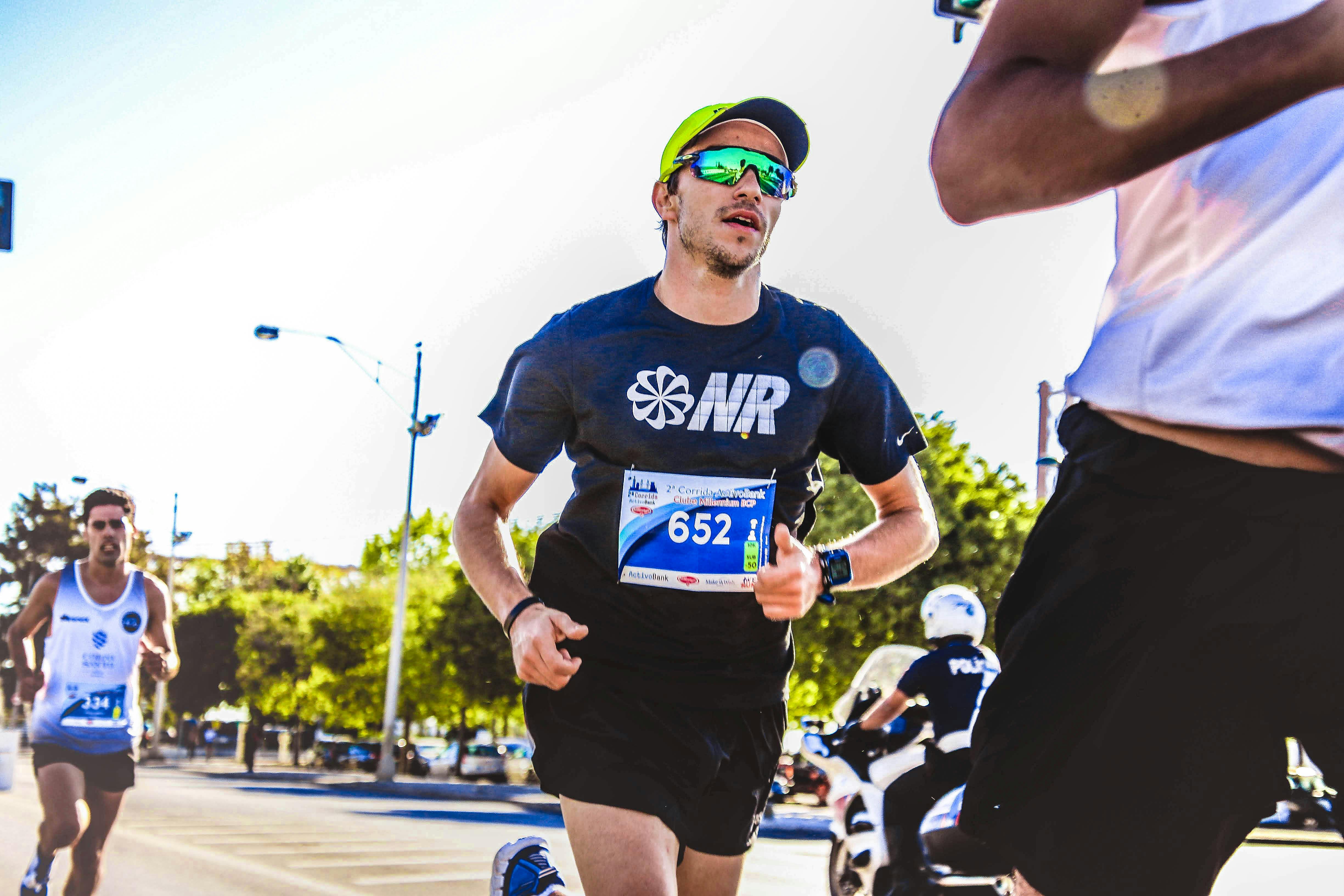
1. Garmin Enduro 2
Purpose-built for ultra-distance events, the Enduro 2 represents Garmin's focused effort to create the ultimate ultramarathon watch. It delivers an astounding 150 hours of GPS tracking (up to 200 hours with solar assistance in sunny conditions), meaning many 100-mile races can be completed using just 50% of the battery.
The built-in LED flashlight is a game-changer for overnight segments—allowing you to briefly illuminate your path or check gear without carrying a separate light source. The Enduro 2 includes all the essential trail metrics plus innovative features like real-time stamina tracking, which helps ultra runners gauge effort distribution over extremely long distances.
Built with a sapphire lens and titanium construction, it withstands the inevitable falls and impacts that occur during technical ultras. The ultra-fit nylon strap provides comfortable long-duration wear, minimizing skin irritation during multi-day events.
Features particularly valuable for ultra runners include ClimbPro (which breaks down long ascents into manageable segments), customizable nutrition alerts, and comprehensive sleep tracking between stages of multi-day races.
While expensive ($1100), if your primary concern is having absolute confidence that your watch won't die during a 100-miler or multi-day adventure, the Enduro 2 delivers unmatched peace of mind.

2. COROS Vertix 2 / Vertix 2S
The Vertix 2's staggering battery specs make it a natural choice for ultra runners pushing extreme distances. With over 100 hours of GPS tracking in full accuracy mode (and up to 240 hours in UltraMax mode), you could potentially complete a 200-mile race on a single charge.
COROS's UltraMax battery mode intelligently combines GPS data with motion sensors to extend battery life while maintaining reasonable accuracy—perfect for multi-day stage races or FKT attempts where every hour of battery counts.
The watch includes detailed offline maps and features a straightforward interface (just two buttons and a dial) that remains easy to operate even when you're sleep-deprived or suffering from decision fatigue 30 hours into an event.
Ultra runners particularly appreciate the COROS platform's stability and clean software—the last thing you need during an all-day (or multi-day) effort is your watch crashing or giving erratic data. The watch is also exceedingly durable and water-resistant (10ATM), ready to handle whatever extreme weather your ultra adventure might encounter.
For those who venture into the mountains, COROS's altitude acclimation feature and AMS (Acute Mountain Sickness) alerts provide valuable safety information—warning you if you might be experiencing altitude sickness during high-elevation ultras.
The Vertix 2 doesn't offer lifestyle extras like music or payments, but for pure ultra-endurance performance, it's one of the most trusted options among elite ultra runners worldwide.

3. Suunto Race (Solar)
The Suunto Race (especially the Solar Titanium version) offers a compelling balance of battery life, weight, and price for ultra runners. Its standard 40-hour GPS runtime easily covers a 100K, while battery saver modes can extend tracking to 70+ hours for longer events.
What makes it particularly suitable for ultras is its comfortable fit—noticeably lighter than Garmin's Fenix/Enduro models, which becomes increasingly important when a watch is on your wrist for 24+ continuous hours. Its quick-charge capability is another major advantage—less than an hour to full charge means even a brief stop at an aid station with a battery pack can add significant runtime.
Suunto's straightforward interface avoids overwhelming you with excessive features and menus, instead focusing on delivering reliable core data when you need it most. The watch includes turn-by-turn navigation for ultra courses—load the GPX file and get alerted for turns, which can be a literal lifesaver when fatigue-induced brain fog sets in during the later stages of an ultra.
While it may not match the extreme battery specifications of the Enduro or Vertix, its lower price point makes it accessible to more ultra runners, and its combination of solid performance with exceptional comfort makes it a worthy contender for events up to 100 miles.
Best Watches for Triathletes
Triathletes need watches that can handle multiple sports in a single event (swim, bike, run) with quick transitions and connectivity to various sensors. Key features include dedicated triathlon modes, waterproofing for swimming, accurate GPS across disciplines, and support for accessories like heart rate monitors, power meters, and cadence sensors. Here are our top recommendations:

1. Garmin Forerunner 965
The Forerunner 965 is the premier triathlon watch on the market today. Its dedicated triathlon mode allows you to track a complete race by simply hitting the lap button to record transitions (T1/T2) between swim, bike, and run segments, with each leg individually timed. It can even auto-detect transitions if you forget to press the button in the heat of the moment.
Sensor connectivity is comprehensive—pair your cycling power meter, smart trainer, running footpod, or swim heart rate strap with ease. The FR965 will even store underwater heart rate data when used with Garmin's HRM-Tri or HRM-Pro straps, giving you complete data for all three disciplines.
The onboard mapping is particularly valuable for cyclists training on unfamiliar routes, providing turn-by-turn guidance during long rides. Despite its powerful feature set, the FR965 remains lightweight and comfortable enough to wear under a wetsuit or during the run without feeling burdensome.
Battery life (approximately 30 hours in GPS mode) easily covers even full Ironman distance events, with power-saving modes available for ultra-distance triathlons if needed.
Triathletes especially appreciate features like Daily Suggested Workouts (which intelligently balance swim, bike, and run sessions based on your current training load) and comprehensive recovery metrics that help manage the demanding training schedule across three disciplines.
Garmin's robust ecosystem, including Connect and compatibility with third-party apps like TrainingPeaks, allows for complex brick workout planning and detailed analysis. Many triathletes find the FR965 so capable that it eliminates the need for a separate bike computer, streamlining their gear setup for both training and racing.

2. Wahoo ELEMNT Rival
Wahoo's entry into the multisport watch market brought genuine innovation with its "touchless transition" feature—the watch can automatically detect when you finish the swim and move to the bike, and then transition to the run, without requiring button presses. For triathletes focused on shaving seconds in transition or those who simply want one less thing to remember in the chaos of T1/T2, this feature alone has won passionate fans.
The Rival integrates seamlessly with the wider Wahoo ecosystem, including KICKR trainers for indoor workouts and ELEMNT bike computers. It offers full ANT+ and Bluetooth sensor compatibility for connecting to all your triathlon gear.
The user interface, adapted from Wahoo's popular cycling computers, is remarkably clear and intuitive—prioritizing readability and simplicity over endless menus and options. Battery life (~24 hours in GPS mode) comfortably covers Ironman and half-Ironman events.
The Rival captures all the essential triathlon metrics: swim data (including open-water distance and stroke rate), precise transition times, and comprehensive run and bike stats. It syncs effortlessly with training platforms like TrainingPeaks for structured workout guidance.
While it lacks the mapping capabilities and extensive analytics of Garmin watches, many triathletes appreciate its streamlined approach—providing exactly what you need during a race without overwhelming you with data. Its round face and minimalist design also make it one of the more stylish options for everyday wear between training sessions.

3. Polar Vantage V3
Polar has deep roots in triathlon training, and the Vantage V3 continues this tradition while modernizing the hardware platform. It supports full triathlon mode for seamless race tracking across all three disciplines, with separate profiles for each sport.
Polar watches are particularly strong in swimming metrics, with the V3 accurately tracking pool workouts (sets, strokes, SWOLF efficiency) and open-water swims. For cycling, the V3 supports all the power metrics triathletes rely on (including normalized power and intensity factor) when paired with standard power meters.
What distinguishes Polar for many triathletes is the depth of physiological insight. The Training Load Pro feature separates cardio impact from muscular strain for each session, allowing triathletes to understand how a long bike ride affects them differently than a tempo run. This granular data helps balance training across disciplines to prevent overtraining in any one sport.
The V3's recovery tracking tools (including the orthostatic test for measuring autonomic nervous system recovery) provide valuable guidance for managing the complex training load that comes with preparing for three sports simultaneously.
With the addition of onboard maps and dual-frequency GPS, the Vantage V3 has closed the technology gap with competitors while maintaining Polar's traditional strengths in physiological analysis. Its claimed 61-hour GPS battery (35-40 hours in our real-world testing) easily covers a full Ironman with plenty to spare.
For triathletes who prioritize training optimization and recovery management alongside accurate tracking, the Polar Vantage V3 offers a compelling combination of analytical depth and modern hardware.
Feature Overview: What Matters and Why
Modern GPS watches pack an impressive array of features. Understanding what they do and which ones matter for your specific needs will help you choose the right watch for your running style and goals.
GPS Tracking & Accuracy
All running watches track distance, pace, and routes via GPS, but they vary in accuracy and capabilities:
Single-band GPS (found in budget and some mid-range watches) works well in open areas but can struggle in cities with tall buildings or dense forests where signals bounce or get blocked.
Multi-band (dual-frequency) GPS is the new gold standard in higher-end watches. By accessing multiple satellite systems simultaneously (GPS, GLONASS, Galileo, BeiDou, QZSS), these watches can pinpoint your location with remarkable precision—distinguishing which side of the street you're on or maintaining accurate tracks through urban canyons.
Multi-band GPS is worth the investment if you run in challenging environments (cities, dense trails) or if precise distance and pace data is important to your training (interval workouts, racing). For casual runners in open parks or suburbs, single-band GPS is usually sufficient.
Heart Rate Monitoring
Wrist-based optical heart rate monitors have become standard across all price points. Today's sensors are quite good during steady-state running—typically within a few beats of chest straps in consistent efforts.
For interval training or very high-intensity work, however, optical sensors can still lag behind rapid heart rate changes. Serious athletes often pair their watches with chest straps for these sessions (most watches support ANT+ or Bluetooth heart rate straps).
Beyond basic heart rate tracking, advanced watches use heart rate data to calculate:
- Training load and recovery status
- Sleep quality and recovery
- VO2 max estimates
- Stress levels throughout the day
Higher-end models from Polar and Garmin also track heart rate variability (HRV) during sleep, providing deeper insights into overall recovery and readiness to train.
Battery Life
Battery performance ranges dramatically—from around 20 hours of GPS tracking on entry-level watches to 100+ hours on endurance-focused models. When evaluating battery specs, consider:
- Your longest anticipated activities (marathons, ultras, multi-day adventures)
- How frequently you're willing to charge the device
- Features that drain battery faster (AMOLED screens, music, always-on displays)
Most watches offer battery management options to extend life when needed—reducing GPS sampling rates, turning off certain sensors, or limiting screen brightness. Some models (particularly Garmin's solar line) can even harvest energy from sunlight to extend runtime.
As a rule of thumb, choose a watch with at least double the battery life of your longest anticipated activity—this provides a comfortable buffer for feature usage, cold weather (which reduces battery efficiency), and battery degradation over time.
Build Quality & Durability
Running watches face harsh conditions—sweat, rain, bumps, and scrapes. Build materials significantly impact durability and comfort:
Cases: Most use fiber-reinforced polymer (plastic) for lightness, while premium models add metal bezels or full titanium bodies for durability.
Screens: Protection ranges from standard glass to Gorilla Glass to virtually scratch-proof sapphire crystal on high-end models. Trail runners and those hard on gear often find sapphire worth the premium.
Water resistance: Standard watches offer 5 ATM (50m) protection—fine for swimming and rain. Premium outdoor models provide 10 ATM (100m) or more for diving and extreme conditions.
Weight: Ranges from ultra-light (30g for COROS Pace 3) to substantial (96g for Fenix 7X), affecting comfort during long runs and daily wear.
While even basic running watches are designed to handle typical running conditions, those venturing into extreme environments or wanting a watch that will last for many years might justify investing in premium materials.
Advanced Metrics & Coaching
Modern watches go far beyond basic pace and distance tracking, offering insights that once required lab testing:
- Training metrics: VO2 max estimates, training load over time, training status (productive, peaking, maintaining), race time predictions.
- Recovery tools: Recovery time advisors, sleep tracking, morning readiness scores, HRV status.
- Running dynamics: Cadence, ground contact time, vertical oscillation, stride length, running power.
- Coaching features: Adaptive training plans, daily workout suggestions, real-time performance feedback.
These advanced metrics are most valuable for self-coached runners serious about improvement. They help structure training effectively, balance workload and recovery, and identify areas for technique improvement.
Beginners might find this data overwhelming, while runners working with coaches might already receive similar guidance. Consider your training approach when deciding how much you'll benefit from these analytics.
Multisport and Sensor Support
For athletes who cross-train or compete in multiple disciplines:
- Multisport modes: Allow tracking different activities in sequence (crucial for triathletes).
- Sensor compatibility: Connectivity with external devices like footpods, bike sensors, power meters, and smart trainers.
- Sport-specific metrics: Swimming efficiency, cycling dynamics, stride length, running power.
Triathletes and multisport athletes should prioritize watches with seamless sport transitions and broad sensor support. Pure runners might focus on running-specific sensors like footpods for treadmill accuracy or running power meters.
Music, Payments, and Smart Features
Lifestyle integration features enhance convenience but affect battery life and price:
- Music storage/streaming: Store songs on the watch or stream from services like Spotify via Bluetooth headphones.
- Contactless payments: Make purchases without carrying a wallet (Garmin Pay, Apple Pay, etc.).
- Notifications: View calls, texts, and app alerts from your connected phone.
- Voice assistants: Issue commands or ask questions (primarily on smartwatch models).
These features are most valuable for urban and commuter runners who want to travel light and stay connected. Trail runners and ultramarathoners might prioritize battery life over these conveniences, though having music for long training runs can be a significant mood booster.
Connectivity & Ecosystem
The software platform behind your watch determines how you'll interact with your data:
- Companion apps: Garmin Connect, Polar Flow, COROS app, Apple Health/Fitness—each offers different analysis tools and interfaces.
- Third-party compatibility: Integration with platforms like Strava, TrainingPeaks, or fitness apps.
- Data richness: Depth of analysis, historical comparisons, trend tracking.
- Community features: Challenges, social sharing, leaderboards.
Consider whether you already have training data in a particular ecosystem, if you use specific third-party services that require compatibility, and how important certain analysis tools are to your training approach.
Conclusion
The running watch market in 2025 offers incredible options at every price point. From budget-friendly performers like the COROS Pace 3 that deliver surprising capability for under $250, to premium adventure companions like the Garmin Fenix that can navigate you through multi-day wilderness epics, there truly is a perfect watch for every runner and running scenario.
When choosing your ideal running companion, consider not just your current needs but where your running journey might take you in the future. A beginner training for their first 5K might be perfectly served by an entry-level model, but if marathon aspirations are on the horizon, investing in a watch with more advanced recovery metrics and longer battery life could be worthwhile.
The good news? GPS accuracy, heart rate monitoring, and build quality have improved dramatically across all price points. Even budget options now deliver performance that would have been considered premium just a few years ago.
Whether you're crushing intervals on the track, exploring remote trails, or fitting runs around your daily commute, today's watches offer the perfect blend of performance tracking, guidance, and convenience to elevate your running experience. The perfect running partner is out there—it's just a matter of matching the right watch to your unique running fingerprint.
Happy running!
Find Your Perfect Running Watch Today!
With this comprehensive guide, you're well-equipped to choose the best GPS running watch for your needs. Remember to consider your running style, training goals, and budget when making your decision.
Explore our top picks and find the perfect companion to elevate your running experience.